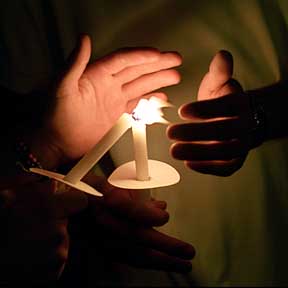 As I stood silently, my candle in hand, I looked around at the faces of about a hundred twenty-somethings at the candlelight vigil. The evening air was heavy with sadness as they gathered to commemorate the life and death of their friend. Her death was tragic. She was pulled from a house fire too late. She survived for a few weeks, but her burns were too severe. Now, two weeks after her death, many at the vigil still looked stunned. You could almost see their thoughts at work, trying to make some kind of sense of it all.
As I stood silently, my candle in hand, I looked around at the faces of about a hundred twenty-somethings at the candlelight vigil. The evening air was heavy with sadness as they gathered to commemorate the life and death of their friend. Her death was tragic. She was pulled from a house fire too late. She survived for a few weeks, but her burns were too severe. Now, two weeks after her death, many at the vigil still looked stunned. You could almost see their thoughts at work, trying to make some kind of sense of it all.
The death of a teenager or young adult is always a tragedy. There is no way to spin it that makes it anything less. No matter the circumstances, a young life coming to an end makes no sense. No explanation softens the reality; no rhyme or reason can make it OK. Whether by illness, accident, or suicide, death at an early age is tragic and always leaves the survivors reeling.
For many of those standing there, I suspect this was their first experience of the death of someone so close to them, so close to their own age. This will be a turning point for them. They will mark their lifelines as “Before her death” and “After her death.” For others, it is yet another significant loss. For my son, standing in their midst, it is his third loss in as many years.
Most of the experts on grief say that the first steps in healing are to acknowledge the loss and to experience the pain. I doubt anyone in the group had been instructed on the process of grief. Yet here they were, intuitively or out of sheer need, their candles burning, acknowledging their loss and feeling their intense pain and confusion in the presence of each other.
Most were dressed in their characteristic black, they were tattooed and pierced and spiked. They live on the fringes of the world I inhabit and they seem clueless about so many things that are essential to my middle-aged, middle class professional world. Yet, they were engaged in a group wisdom. Somehow they knew that grief is more bearable and more healing when shared with those who are also grieving. Many at the vigil had been together daily since their friend’s death. A few in attendance had been rescued from the fire that took her life, and now they were standing in the front yard of that house, looking at each other and up at her second-story window, charred and boarded up.
This young woman’s life, like many of those standing in the yard, had a trajectory that was clearly forward and upward. She was working to support her siblings while also saving for college. She was building friendships that were going to last forever. She was living her life with all the gusto, drama, joy, and pain that any young adult experiences. Her death throws all sorts of existential confusion at the survivors. It calls into question the purpose and meaning of life itself at a time when life holds so much promise and possibility. It calls into question their own mortality at a time when they feel physically invulnerable.
I learned long ago from my own grief and from helping others with their grief, that you can’t take away the pain of grief. It’s a given. You can, however, by being together, by talking and laughing and crying together, even by standing in silence together, take away some of the fear and the loneliness that comes with the pain.
 They have figured out on their own that isolation inhibits healing. There are no answers to be found, but togetherness helps. Huddling together is often the best way to hold on until we regain our footing and can take our next step.
They have figured out on their own that isolation inhibits healing. There are no answers to be found, but togetherness helps. Huddling together is often the best way to hold on until we regain our footing and can take our next step.
As I stood there with my candle, dusk settled and the sky gradually darkened. Those of us who happened to look up at the right moment saw a shooting star. It was bright and fast, and then it was gone.
0 Comments until now
Add your Comment!